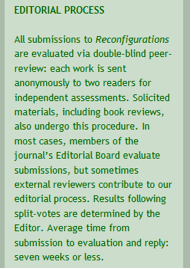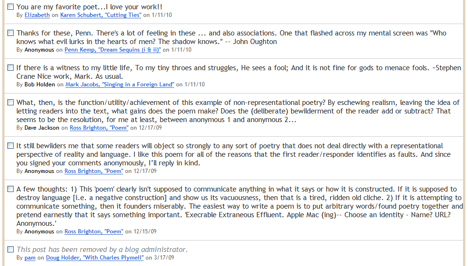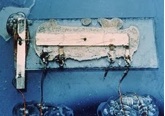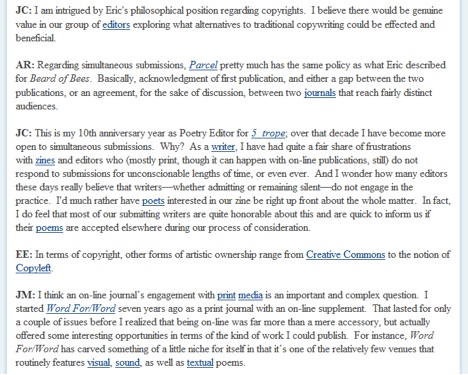WYSIWYG Poetics: Reconfiguring the Fields for Creative Writers and Scholars
Skip other details (including permanent urls, DOI, citation information)
: This work is licensed under a Creative Commons Attribution-NonCommercial-ShareAlike 3.0 United States License. Please contact [email protected] to use this work in a way not covered by the license.
For more information, read Michigan Publishing's access and usage policy.
Abstract
This article addresses a selection of publications from RECONFIGURATIONS: A Journal for Poetics & Poetry/Literature & Culture. Reconfigurations cultivates a vigorous blending of conventional and non-conventional forms of communication. Our work turns upon generative contradictions. We are both outside of established institutional hierarchies of process and production (we are online in the form of a blog) and we are the epitome of such systems (we are peer-reviewed). We seek to gather and present a judiciously selected diversity of genres/modes and forms of discourse. We exist as a dynamic space for readers, artists, writers, and scholars invested in tradition and innovation. Such dedication to both/and, such inclusion of opposition, is required by our project of reconfiguration.
This article[2] concerns the extent to which e-journals are working synergistically within and through the fields of knowledge, generating possibilities for traditional and innovative forms of writing. My focus here addresses intersections among matters of creation and research, authorship and publication, readership and information access, which I will illustrate with a selection of accomplishments, since 2007, from the peer-reviewed, MLA-indexed, EBSCO-distributed, electronic journal that I design, edit, and publish: RECONFIGURATIONS: A Journal for Poetics & Poetry/Literature & Culture, ISSN: 1938-3592, http://reconfigurations.blogspot.com/.

Reconfigurations is an open-access, annual, independently managed journal that aims to build bridges among radically different communities: creative writers and scholars; artists and critics; university/college faculty and non-academics; independent presses with local volunteers and commercial presses with national/international distribution networks. We publish all of our work under a Creative Commons (Attribution-Noncommercial-No Derivative Works) 3.0 unported license[4] in tandem with our Copyleft policy, which enhances our open-access distribution, adaptation, meme-ing/versioning/remixing permissions, all of which may be negotiated for various desired outcomes (including hard copy reprints):

Within that hybridized context, Reconfigurations cultivates a vigorous blending of conventional and non-conventional forms of communication. Our work turns upon generative contradictions. We are both outside of established institutional hierarchies of process and production (we are online in the form of a blog) and we are the epitome of such systems (we are peer-reviewed). We seek to gather and present a judiciously selected diversity of genres/modes and forms of discourse. We exist as a dynamic space for readers, artists, writers, and scholars invested in tradition and innovation. Such dedication to both/and, such inclusion of opposition, is required by our project of reconfiguration.
Since launching in 2007, Reconfigurations has received nearly a thousand submissions, all of which have gone through our standard peer-review process.

We have thus far published four volumes, each embracing a capacious theme: contingency, process, immanence/imminence, and emergence. Altogether those volumes contain 298 individual works, most of which fall into recognizable forms, including: book reviews, critiques, dialogues, essays, interviews, poems, and prose fictions/short stories. Many of our publications, however, challenge status quo categorization, such as: image-text/visual poems; graphic novels; remixed conversations; open-source adaptations/translations; and guest-curated galleries of international visual art, writing, and scholarship. Across those four volumes, we have published ten special features, each shaped by a topic that engages current questions and concerns about digital media. Four of those special features present innovative, dialogic assemblages facilitated by and co-published either on open-access wikis or in collaboration with other e-journals: “Difficult Praise” (2007),[7] “Reflections on Electronic Publishing” (2008),[8] “Review Review” (2009),[9] and “Emynona Noenef, fénéon reconfigured” (2010).[10]
Since the release of Volume One: Contingency (2007), our site has registered over 400,000 hits (which, of course, break down into highly specific terms that we obtain from Google Analytics).[11] A few of our works have been reprinted in hard-copy form, and several of our authors have positively navigated their tenure and promotion cases by highlighting their publications in electronic literary arts and scholarly journals such as ours.[12] Having already garnered sponsorship from the University of Denver’s Penrose Library and, in 2007, ISSN registration with the Library of Congress, Reconfigurations was soon thereafter catalogued by indexing services, such as Duotrope, Modern Language Association, Open J-Gate, and WorldCat (among others).[13] After two successful years of our work, EBSCO offered Reconfigurations a distribution contract, which now provides global access to most of our publications in PDF form. At no additional cost to their subscribers, EBSCO bundles selections from Reconfigurations into suites of information services. Some hypertext documents, wiki-enabled publications, and other WYSIWYG features specific to our platform and edited volumes are not submitted to EBSCO and thus remain live with Reconfigurations at our site. We have accomplished all of these things with Blogger (which has performed marvellously well) and with a relatively small and dedicated editorial team of fifteen colleagues (from the US and abroad) who volunteer their time and energy to this grand adventure. After the release of Volume Five: Disappearance (2011), we will reflect on the journal’s development and future potential, including our likely migration to a new publishing platform, such as Open Journal Systems.[14]
When I began imagining Reconfigurations in 2005, I had much to discover and figure out through apt mistakes, chance, luck, and apposite experiments. I certainly could not (and would not) have reached our current level of achievement without the sage advice of colleagues and friends, and the collective effort of our authors and my editorial team. One of the most exciting and, I would argue, significant levels of our contribution has been the journal’s active reconfiguration of the field, making room for what could be called WYSIWYG poetics.
We are all in the grips of an unsettling and revitalizing paradigm shift from recognizable values granted to knowledge fields produced within, organized by, and distributed through representational discursive practices and technologies toward the mercurial digital realm of contingent WYSIWYG forms of real-time, tele-cultural, communication-and-image instrumentation.[15]

Content is increasingly born digital at this early time in the twenty-first century. Content “becomes fluid in the network, in the universal solvent that is digital media, where every representation can be reduced to bits and transformed and recombined indefinitely. Our society faces a media landscape utterly unlike anything previous generations could imagine.”[17] To illustrate the tectonic force of this shift, I would simply invoke (beyond the epigraph to this essay) a selection of current definitions of WYSIWYG from the Oxford English Dictionary, Encyclopaedia Britannica, Urban Dictionary, and Wikipedia as a way of suggesting the bracing adventure ahead for the vast majority of artists, educators, scholars, publishers, writers, and students in all of the traditional knowledge fields. How might such a rhizomatic terrain of WYSIWYG’s whimsical and heterogeneous origin, aleatory & meta-discursive development, kinetic and potential signification be usefully transcribed for the rhetorical design, theoretical aims, and practical means of open-access e-journals?
1982. Byte. Apr. 264/2: ‘What you see is what you get’ (or WYSIWYG) [pronounced ‘whizziwig’] refers to the situation in which the display screen portrays an accurate rendition of the printed page.[18]
The next wave of GUI innovation occurred at the Xerox Corporation’s Palo Alto (California) Research Center (PARC), to which several of [Douglas] Engelbart’s team moved in the 1970s. The new interface ideas found their way to a computer workstation called the Xerox Star, which was introduced in 1981. Though the process was expensive, the Star (and its prototype predecessor, the Alto) used a technique called “bit mapping” in which everything on the computer screen was, in effect, a picture. Bit mapping not only welcomed the use of graphics but allowed the computer screen to display exactly what would be output from a printer—a feature that became known as “what you see is what you get,” or WYSIWYG.[19]
Pre-WYSIWYG word processing applications relied on different "modes" for various actions, such as editing and viewing. At that time, you couldn’t "see" exactly the way a document would look until you printed it or viewed it (outside of edit mode).[20]
The phrase was originally a catch phrase popularized by Flip Wilson’s drag persona "Geraldine" (from Rowan & Martin's Laugh-In in the late 1960s and then on The Flip Wilson Show until 1974), who would often say "What you see is what you get" to excuse her quirky behavior. The phrase proved popular enough to become the title of the hit single "Whatcha See is Whatcha Get" by The Dramatics in 1971.[21]
Following the OED’s lead (from the 1984 Scientific American essay, “the image on the screen is always a faithful representation of the user’s illusion”), I would propose a robust, non-dialectical formulation of WYSIWYG without invoking any agonistic struggles between center and circumference, style and substance, form and content, outside and inside, programmer and user, interface and implementation, text and hypertext, etc.[22] Simply put: I would, by apophasis, affirm the liminal point, the aporetic singularity of an image that synergistically informs/shapes a constitutive illusion.[23] WYSIWYG poetics—grasped as the fusion of poiesis (substantial making) and vates (magical seeing) —rides on its own eidetic melting along the cusp of the writer’s/reader’s noetic/ludic/hylic horizon of expectation.[24] These reflections take a preliminary step toward a more complete discourse.[25]
E-journals have the potential to make distinctive advances in the Humanities. Interactive design elements and open-access publishing platforms may be used strategically to create generative relationships among scholars, archivists and librarians, artists, writers, readers, editors and publishers, and communities within and beyond academia. Emergent channels for communication and production become possible within and across the disciplines. Hybrid forms of discourse challenge aesthetic, generic, and methodological standards. Everything about the creation, distribution, evaluation and use of digital scholarship and creative work must be re-imagined: authorship and audience, content and copyright, persona and politics, temporality and tenure. Colleges and universities in the U.S. are just beginning to recognize the immediate impact and potential consequences of this shift, as illustrated by the many extraordinary efforts to transform twentieth-century libraries into campus-wide, interactively designed research and learning hubs for the twenty-first century, such as the academic commons project currently under construction at the University of Denver.[26]
Open-access platforms with built-in two-way functionality provide readers with opportunities to become active contributors to the production of knowledge and the shaping of new literary forms. Those avenues for creative and scholarly exchange reciprocally pose real difficulties to authors, editors and publishers, archivists and librarians. Vital questions easily outnumber standardized best-practices. Should a reader’s comments become part of the published record at the e-journal’s site? Should such dialogue be represented in archived, searchable, digital repositories?

Should open-access policies also accommodate open-source republication and distribution permissions? If so, how so and under which circumstances? And if not, then how and why will each of those concerns be addressed in meaningful ways for the communities that matter to individual e-journals? Within and against such revolutionary forces, how and why might e-journals negotiate the old-fashioned practice of peer-review? What roles might peer-review play (or not) in the realm of digital publishing?
At Reconfigurations, we seek our readers’ input, but we also reserve the right to edit and/or select the comments and questions we would wish to broadcast alongside our authors’ works. In one instance, limned in Figure 5, we chose to delete one slightly aggressive published statement in response to one of our readers who suggested that we ought to consider such action; as a way of respecting both of those opposing views, we omitted the potentially offensive remark and allowed the phrase “This post has been removed by a blog administrator” to remain. The PDF versions of our volumes that we submit to EBSCO capture all of that marginalia up to the point in time of their delivery for distribution.
At the journal’s site, all of our publications remain open for further contributions from readers/writers, including edits and any elaborations on the works, as determined by our authors in dialogue with our editorial team. For example, one of our special features in Volume Two: Process (2008) was expressly designed for open-source remixing: John Bloomberg-Rissman’s remarkable long-poem, No Sounds of My Own Making, with an introduction by Karla Kelsey.[28] Our readers created three audio remixes and posted their comments and links to those parallel works. All of these dialogic features have been made possible by Blogger.
I chose Blogger in 2005 when my ideas for Reconfigurations were inchoate, sanguine and roughhewn, and I have been pleased ever since with our platform’s effectiveness.

I knew what I wanted: a free, open-access publishing platform; simplicity and reliability; development potential; built-in troubleshooting; and Google visibility. I also experimented with WordPress (which would have been equally well-suited to all of those needs) but ultimately decided to begin designing the journal on Blogger for one key reason: I wanted Reconfigurations to embody and enact the digital aesthetic; to feel and function NOT like paper while also playfully invoking the aura of book culture (where appropriate).

Our accomplishments, strengths, and weaknesses arguably turn upon that crux. The platform’s constrained resilience has thus far accommodated everything we have wished to publish. Our site’s somewhat rudimentary appearance, however, might signal (for some of our potential authors and readers) a lack of savvy and seriousness.

Notwithstanding such criticism, Blogger also raises our wager: Reconfigurations is the first-ever such electronic journal in the US to receive ISSN registration, MLA indexing, and EBSCO distribution. We have effectively merged the antithetical worlds of small press and academic publishing.
Each of our annual volumes gathers a rich array of works. Volume Four (2010): Emergence “is packed with craft & research, difference & innovation, dialogue & figuration, song & vision:”[32] thirty-two poems, one interview, two essays, nine visual poems, three graphic novels, three dialogues, two image-texts, four fictions, two reviews, and three critiques. Many (if not most) defy ready categorization, such as Andy Fitch’s “Transcript of June 3rd”, or Sheila Murphy’s “Three Poems.”[33] One special feature, “Graphic Nonfiction: A Look,” curated and introduced by Christy Rowe, presents three commix: The Wherecoyote by Caroline Picard; Noble Dust by Jenna Allen, David Bowen, and David Myers; and the debut of Howard Saunders’ epic memoir, AxeMan, which was subsequently published in hard copy form by Upstream Productions.[34] Another special feature in Volume Four offers a conversation between poets Bin Ramke and Andrea Rexilius that includes links to five short films on YouTube from the interview.[35] Volume Three (2009): Immanence/Imminence collects twenty-one dialogues, seventeen essays, three fictions, twenty image-texts, sixty-four poems, six reviews, and (in addition to the aforementioned “Review Review”) three curated special features: Obododimma Oha’s “Baobab Tree: Local Knowledge/Global Politics”—an anthology of articles, poems, and works of visual art that question relationships “between the West (or the Westernized) and the non-West”;[36] a gathering of “dark, psychic, sharp” poems by emerging writers, “Myth, Erasure & Consequence,” selected by Page Hill Starzinger;[37] and “Outside-In: New Zealand Poetry & Poetics” edited and introduced by Bryan Walpert.[38] Volume Two (2008): Process (Fields of Signification) collects five reviews, four interviews, fifty poems, five essays, two stories, one conversation, the above-noted “Editors-Wiki,” and one splendid comic, Laura Johnson’s Another World, “an interweaving and interpretation of the cosmologies presented by Milton in Paradise Lost, Neil Gaiman in the Sandman series, and Philip Pullman in the His Dark Materials trilogy.”[39] Volume One (2007): Contingency gathers five essays, three interviews, seventeen poems, six prose works, seven book reviews, and the above-mentioned, collaboratively-written special feature, “Difficult Praise,” which we published simultaneously on two platforms: on our Blogger site, and on an open-access wiki hosted by PBWorks (formerly PBWiki).[40]
As previously noted, three of our special features since 2007 have invited artists, writers, readers, editors, scholars, and publishers to participate in conversations facilitated via wikis, which I have launched and then curated on PBWorks. Those collaborations have been challenging and rewarding, especially with regard to our shared (albeit contentious) interests in digital media. Four editors of electronic poetry journals participated in “Editors-Wiki: Reflections on Electronic Publishing,” which we shaped for Volume Two (2008): Process.[41] Once released, the wiki offered a few questions as a way of suggesting possible directions for their discussion.
- How do you see your own projects contributing to the larger field of electronic publishing?
- How and why (or why not) do you want your journals/presses to engage with print media?
- Who are (and are not) your audiences?
- How important to you is the relationship among digital design, content, and audience?
We allowed several weeks for the conversation to unfold. During that time, I did my best to stay out of the way, checking in only once or twice to ask our guests if they would like to have more time. When they were ready to return the wiki to us, I lightly edited the format, added selected hyperlinks to underscore noted topics, and then sent the wiki out to my editors for an evaluation. Our contributors’ discussion about simultaneous submissions and shared-copyright, for example, articulates particularly apt and vital reflections:

Everything about the creation, distribution, evaluation and use of digital scholarship and creative work must be re-imagined. All of our publications at Reconfigurations prompt everyday possibilities for new ways to discover the local/global community: writers and readers, editors and publishers, artists and scholars, librarians and cataloguers, distributors and remixers. Our wiki-conversational-special-features at Reconfigurations embody those qualities in vivid detail, as they animate clusters of WYSIWYG characteristics, including peer-reviewed, simultaneous, multi-platform publication; collaborative authorship curated by an editorial board; open-access and open-source content; multi-media and cross-disciplinary forms of discourse; and hypertext dialogue. Should commentary become part of the content? Should such contingent material be captured beyond the journal’s scope in archived, searchable, digital repositories or in library catalogues? Should open-access policies also welcome open-source permissions? Questions such as those call for advocacy and involvement, vigilance and serendipity.[43]
Our wiki-dialogic-special-features remain live and open for further commentary at our journal’s site as well as on their individual PBWorks locations. For precisely those reasons, neither MLA nor EBSCO will index or distribute them: the content is deemed unstable and unreliable. Every year, when I create the PDF versions of each published volume to submit to MLA and EBSCO, I have new opportunities to defend any number of our publications that might be perceived as “problematic”: sometimes the visual poetry; at other times, the graphic novels, or the hybrid fictions. We are currently seeking submissions for two special features in Volume Five (2011): Disappearance that will challenge such boundaries yet once more: a guest-curated gallery of texts which combine fiction/poetry and theory/criticism; and a collaboratively assembled, open-source archive of para-texts.
Beginning in 2012, one of our top priorities for the journal’s next stage of development will be the creation of a new partnership among Reconfigurations, the Colorado Alliance Digital Repository,[44] the Penrose Library at the University of Denver, and local small presses—an intentional community dedicated to the preservation and distribution (in digital and print forms) of our most distinctive works. We look forward to that next level of community engagement and creative/scholarly reconfiguration.
W. Scott Howard received his Ph.D. in English and Critical Theory from the University of Washington. He teaches in the Department of English and in the Digital Media Studies Program at the University of Denver, where he is Associate Professor. Howard edits and publishes two electronic, annual, peer-reviewed journals: Reconfigurations, A Journal for Poetics & Poetry / Literature & Culture; and Appositions, Studies in Renaissance / Early Modern Literature & Culture. His essays on poetics and poetry have appeared in many journals and books, including: Double Room, Word for / Word, Denver Quarterly, Reading the Middle Generation Anew (Iowa), Studying Cultural Landscapes (Arnold & Oxford), and Printed Voices (Toronto). His electronic poetry chapbook, ROPES, is available from Ahadada Books (2010); his co-edited volume, The Divorce Tracts of John Milton: Texts & Contexts, from Duquesne University Press (2010). Professor Howard is the recipient of fellowships and grants from the Modern Language Association, the PEW Charitable Trusts, and the National Endowment for the Humanities. For more information, see: http://mysite.du.edu/~showard/ & http://portfolio.du.edu/showard
Notes
Oxford English Dictionary, http://www.oed.com/.

My work here emerges from recent conference presentations, including “E-Journals & Interactive Design: Re-mediating the Fields for Scholars & Creative Writers,” Provost’s Conference: October 29, 2010, University of Denver, http://library.du.edu/penrosepen/videos-from-the-provost-conference. I wish to thank my colleagues, Rafael Fajardo and Brian Bates, for their spirited & substantive contributions to this essay’s development.

Hartmann Schoppers, “Panopleia” (1568). Image source: Wikipedia. Reconfigurations publishes a variety of images in our sidebar, some of which we obtain with permission from private collections; others, from open-access resources.

For the Creative Commons text of that license, see: http://creativecommons.org/licenses/by-nc-nd/3.0/.

Our open-access permissions and policies (and these icons) appear on every page in the ‘footer’ on our journal’s site.

All of our policy and process information may be found on our sidebar, which also provides clusters of thematically organized links to a wide range of web resources, including: AWP and PennSound podcasts, booksellers and blogs, archives and libraries, gateways to other e-journals in the field, and so much more.

See: “Difficult Praise: A Conversation After Robert Pinsky’s ‘In Praise of Difficult Poetry’,” http://reconfigurations.blogspot.com/2007/11/difficult-praise.html, a wiki-collaboration among six writers.

See: “Editors-Wiki: Reflections on Electronic Publishing,” http://reconfigurations.blogspot.com/2008/11/reflections-on-electronic-publishing.html, a wiki-dialogue with editors of four open-access, electronic poetry journals.

See “Review Review,” curated by Jared Schickling, http://reconfigurations.blogspot.com/2009/11/review-review.html, a wild rumpus of meta-fictive critiques placed in apposition to “a rather large and diverse critical forum in the first issue of Mayday Magazine, http://www.maydaymagazine.com/issue1JOHNSON.php, which replies to a letter from Kent Johnson to Poetry.”

See http://reconfigurations.blogspot.com/2010/11/emynona-noenef-feneon-reconfigured.html. This special feature, a wiki-conversation involving between 25 and 50 participants, is still in-progress at the time of this essay’s composition. Later this year, our editors will review Emynona Noenef’s free-wheeling discussion for possible publication in Volume Five.

For example, during the month of May, 2011 (typically one of our least active periods) the journal received 401 visits from 36 countries/territories; 883 pageviews; and 319 unique visitors of which 66.58% were new to the site.

The vastness of this contentious topic exceeds the scope of my work here. See: “Report of the MLA Task Force on Evaluating Scholarship for Tenure and Promotion,” http://www.mla.org/tenure_promotion; and Catharine R. Stimpson, “A Dean’s View of the MLA Report,” Inside Higher Ed, 6 February, 2007, http://www.insidehighered.com/views/2007/02/06/stimpson. For a rich collection of essays on the emerging field of digital humanities, see: Culture Machine, 12 (2011), http://www.culturemachine.net/index.php/cm/issue/view/23.

These cataloguing and indexing resources do not gather information about the overwhelming majority of electronic, small press literary arts journals. See, for example: Spencer Selby’s List of Experimental Poetry/Art Magazines, http://www.selbyslist.com/; and Silliman’s Blog, http://ronsilliman.blogspot.com/.

I’m elaborating upon a formulation from Lev Manovich’s The Language of New Media (Cambridge: MIT Press, 2001), 16-17.

Integrated circuit of Atmel Diopsis 740 system (c. 2007). Image source: Wikipedia. This image bears a striking resemblance to the ubiquitous floor plan for a variety of buildings, including a library.

John W. Maxwell and Kathleen Fraser, “Traversing The Book of Mpub: an Agile, Web-first Publishing Model,” The Journal of Electronic Publishing, 13.3 (2010), http://hdl.handle.net/2027/spo.3336451.0013.303.

Oxford English Dictionary, http://www.oed.com/.

Encyclopædia Britannica, http://www.britannica.com/EBchecked/topic/650293/WYSIWYG.

Urban Dictionary, http://www.urbandictionary.com/.

Wikipedia, http://en.wikipedia.org/wiki/Main_Page.

See Richard Lanham, The Economics of Attention (Chicago: University of Chicago Press, 2006), 42-64; and George Landow, Hypertext 3.0 (Baltimore: The Johns Hopkins University Press, 2006), 1-52.

Our journal’s title, Reconfigurations, also signals this concept, echoing Marshall Mcluhan: “The viewer of the TV mosaic, with technical control of the image, unconsciously re-configures the dots into an abstract work of art.” See: Understanding Media (New York: McGraw-Hill, 1964), 313.

Noetic (intuition)/ludic (play)/ hylic (matter). This elaboration upon Gadamer’s multi-dimensional theory of horizons of interpretation also involves thetic (setting forth) and predicative (syntactic) registers, thus positing a five-fold epistemology that would combine key principles from neo-Platonism, phenomenology, hermeneutics, semiotics, and poetics. This articulation also engages with Julia Kristeva’s critique of the Husserlian transcendental ego, affirming that “there is within poetic language (and therefore, although in a less pronounced manner, within any language) a heterogeneousness to meaning and signification.” See “From One Identity to Another,” trans. Thomas Gora, Alice Jardine, and Leon S. Roudiez, Critical Theory Since Plato, ed. Hazard Adams (Fort Worth: Harcourt Brace Jovanovich, 1992), 1167. Readers familiar with Robert Frost’s essay, “The Figure a Poem Makes,” will hear the resonance: “Like a piece of ice on a hot stove the poem must ride on its own melting.” See Twentieth-Century American Poetics, ed. Dana Gioia, David Mason, Meg Schoerke (Boston: McGraw Hill, 2004), 12.

While Manovich aptly critiques the myth of digital interactivity, we would do well to note the contingency and promise of collaboration between designers and users: “To design a digital artifact is to design an experience . . . to choreograph the experience that the user will have.” See: Jay David Bolter and Diane Gromala, Windows and Mirrors: Interaction Design, Digital Art, and the Myth of Transparency (Cambridge: MIT, 2003), 22. Analog artifacts, of course, should be celebrated not only as partners, but as exemplars in the production of such co-creative fields of experience. Johanna Drucker’s notion of “configuration,” for example, would recognize a kindred via media between transparency and materiality: “the nature of configured meaning within code (again, at the fundamental level of stored, binary sequences) should be read back into the material world in its variously layered interpretations: the first, meta-level of idea coming into being as form and grasped as sense, which I take to be the originary inscription of code; the secondary level, in which form is read as meaning, with all the complexities of iconography, symbolic imagery, and aesthetic inflection; and a third level in which style and specificity engage with ideology, with the specific historical, cultural, and institutional discourses of power.” See “Intimations of Immateriality: Graphical Form, Textual Sense, and the Electronic Environment,” Reimagining Textuality, ed. Elizabeth Bergman Loizeaux and Neil Fraistat (Madison: University of Wisconsin Press, 2002), 174.

See: Steve Kolowich, “Bookless Libraries,” Inside Higher Ed, November 6, 2009, http://www.insidehighered.com/news/2009/11/06/library; Robert Darnton, “5 Myths about the ‘Information Age’,” Chronicle of Higher Education, 17 April, 2011, http://chronicle.com/article/5-Myths-About-the-Information/127105/; Kevin Kiley, “No Room for Books,” Inside Higher Ed, April 27, 2011, http://www.insidehighered.com/news/2011/04/27/university_of_denver_removing_most_books_from_its_library; and Jennifer Howard, “Tomorrow's Academic Libraries: Maybe Even Some Books,” Chronicle of Higher Education, May 8, 2011, http://chronicle.com/article/Tomorrows-Academic-Libraries-/127393/.

All of our publications at Reconfigurations include two-way functionality and we encourage our readers to post their comments and questions, which we lightly moderate.

See respectively http://reconfigurations.blogspot.com/2008/11/john-bloomberg-rissman-no-sounds-of-my.html; and http://reconfigurations.blogspot.com/2008/11/karla-kelsey-introduction-to-no-sounds.html. “No Sounds” comprises just over 14,000 words.

This information appears on every page in the ‘header’ on our journal’s site.

Journal editors, “Becoming Changes: Notes on Emergence,” http://reconfigurations.blogspot.com/2010/11/editors-becoming-changes-notes-on.html.

See, respectively, http://reconfigurations.blogspot.com/2010/11/andy-fitch-transcript-of-june-3rd.html; and http://reconfigurations.blogspot.com/2010/11/sheila-murphy-3-poems.html.

See, respectively, http://reconfigurations.blogspot.com/2010/11/christy-rowe-graphic-non-fiction.html; http://reconfigurations.blogspot.com/2010/11/caroline-picard-wherecoyote.html; http://reconfigurations.blogspot.com/2010/11/dave-myers-david-bowen-jenna-allen.html; and http://reconfigurations.blogspot.com/2010/11/howard-saunders-who-is-axeman.html.

See “Bin Ramke on Folding an Origami Crane, Laura (Riding) Jackson, the Pastoral and More,” http://reconfigurations.blogspot.com/2010/11/andrea-rexilius-bin-ramke-on-origami.html.

See http://reconfigurations.blogspot.com/2009/11/baobab-tree-local-knowledge-global.html.

See http://reconfigurations.blogspot.com/2009/11/myth-erasure-consequence-selected-poems.html.

See http://reconfigurations.blogspot.com/2009/11/new-zealand-poetry-poetics.html.

See http://reconfigurations.blogspot.com/2008/11/laura-johnson-another-world.html.

See http://reconfigurations.blogspot.com/2007/11/difficult-praise.html; and http://exqui-wiki-site.pbworks.com/w/page/6976218/FrontPage.

This wiki-conversation included: Joel Chace, Poetry Editor, 5_trope, http://www.webdelsol.com/5_trope/; Eric Elshtain, Editor, Beard of Bees, http://www.beardofbees.com/index.html; Jonathan Minton, Editor and Publisher, Word For/Word, http://www.wordforword.info/; and Andrea Rexilius, Editor and Publisher, Parcel, http://www.parceljournal.org/. See: http://reconfigurations.blogspot.com/2008/11/reflections-on-electronic-publishing.html.

See “Editors-Wiki: Reflections on Electronic Publishing,” http://transpositions.pbworks.com/w/page/22431011/FrontPage. We welcome simultaneous submissions at Reconfigurations and have, in a few instances, arranged for simultaneous publication. See, for example: Jessica Baron, "After Neo Rauch," Volume Two (2008): Process, http://reconfigurations.blogspot.com/2008/11/jessica-baron-after-neo-rauch.html.

“The real challenge lies in the dynamics of web 2.0 culture—its constant innovation, energy, and its unpredictability.” See: Lev Manovich, “The Practice of Everyday (Media) Life,” Re_Action: The Digital Archive Experience (Roskilde, Denmark: Museum of Contemporary Art, 2009), 183.

